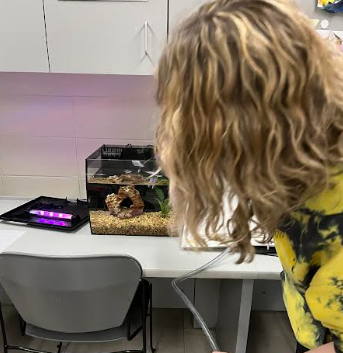During the second semester, the Aquarium Club installed fish tanks on the second floor of the north building with the help of social studies teachers to continue bringing marine life into classrooms.
The fish have added life and discussions to the classrooms.
“It is nice to have almost like a life source in the room. It provides a calming energy. It is nice to look at and provides an interesting way to engage students in conversation,” said Aquarium Club Sponsor and AP United States History teacher, Jonathan Smith.
Teachers taking care of the fish get the opportunity to learn more about the animals.
“I learned about the nitrogen cycle and that a bunch of extra that blooms in the tank and that could be dangerous. Water changes early on are important which is why I think I had to return my fish to the pet store,’” said Smith.
The fish provide ways to help students stay focused during tests and quizzes.
“The trickling water is relaxing to hear and the fish is something for people to focus their wandering eyes on from time to time,” said Dan Kovacs, World Studies and US History teacher.
Teachers with fish play an important role in making sure the fish stay alive.
“You just have to feed them at least every two and students have enjoyed the opportunity to feed the fish,” said Kovacs.
The Aquarium Club takes the fish from the north cafeteria fish tank to put into smaller groups.
“So I just kind of pick the schooling fish that are in small groups just so we could have multiple fish that go together,” said Kovacs.
The fish have provided incentives for students to do well in class activities.
“Before a unit test we were playing Fishtopia and I won. I knew Mr. Smith was not going to give me extra credit so I asked if I could have a fish named after me,” said Avery Benderoff ‘25. “I picked one in the corner with a broken tail because it was the only one that was distinct, and then two weeks ago it just died.”
The fish (who shall not be named) was ill before Smith took it in.
“When Mr. Smith got the fish it had a tumor on its tail and just died of natural causes. She was very well loved in that classroom,” said Aquarium Club leader Audrey Bagnall ‘25.
The aquarium club does its best to make sure the fish are content.
“Most of them seem pretty happy. They do not fight or anything and do not show any clear signs of stress,” said Bagnall.
However, the number of fish has decreased since being installed.
“There is one fish that disappeared. We did not even find the body. Then another fish died two weeks ago,” said Kovacs.
Despite being well-fed, fish eating each other is not uncommon for the species.
“Fish are cannibals. The fish in Mr. Kovacs’s tank may have been eaten. But sometimes they just die out of your control,” said Bagnall.
The aquarium club gets lots of help from the school janitorial staff to help maintain the tanks.
“Essie, a member of the janitorial staff, helps us get water to fill the tanks and lets us use the closet for supplies,” said Bagnall.
The club provides ways for the fish to get taken care of over days off from school.
“Over short breaks, I buy a block of food and over summer break I’m going to put them back in the north cafeteria tank that has an automated feeder. We also have someone who helps take care of the bigger tanks and checks on them during the summer,” said Bagnall.
The fish are currently in three tanks on the second floor of the old building due to convenience.
“It was Mr. Smith’s idea to put them all on the second floor to make it easier to clean and all the teachers just happened to be social science teachers,” said Bagnall.
The club hopes to continue to add fish tanks throughout the school year.
“There are more tanks to add to classrooms but we are out of gravel, so hopefully we can get more soon,” said Bagnall.
Overall, the fish have caused no issues and have brought joy to the classes.
“I have not had any complaints, they have all had good things to say about it. I really think it’s a way to bring the classroom together,” said Bagnall.





